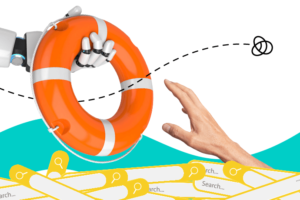
Key Changes in E-Learning Over the Last 25 Years
When I considered identifying the most significant impacts of online learning over the last 25 years, I realized it wasn’t as simple as its initial premise.
Creating this list required me to look beyond just learning systems and content creators (formerly known as authoring tools).
I had to consider other types of learning technology, content itself, and even core standards.
It wasn’t just saying, “Here are the top things, which is why they’re great.” Instead, I needed to analyze the past 25 years’ positive and negative effects.
The goal was to determine whether these impacts have benefited everyone or if we have learned to correct any issues that arose.
Learning systems
The first type of learning system was an LMS, which stands for Learning Management System. Another early system was the LCMS, or Learning Content Management System. These were the two big players when systems first got going.
When considering these systems, I had to consider the system type, the vendors, and their impact. There is a significant misconception about why LMSs were created.
Some vendors today claim that LMSs were created for compliance training or regulatory learning, but this is untrue. LMSs were made because those running training and L&D needed to know whether a person understood and comprehended the material.
In instructor-led training, it’s challenging to gauge comprehension. You can have someone take an exam at the end, but this only shows if they are good at memorization or can apply pieces of knowledge.
It doesn’t guarantee proper understanding and synthesis.
Long sessions were not feasible in corporate settings. Data shows that attention spans max at 45 minutes, yet many sessions go beyond this.
Evaluations using Likert scales were also problematic, as they often provided misleading data.
An LMS was established to address these issues by determining what learners know and what they need to focus on.
For example, ideally, there should be no more than 25 people in technology training, and the pace should match the instructor.
If learners don’t comprehend something, they must revisit the session, which costs time and money.
The LMS helps manage this by providing a structured learning path.
Over the past 25 years, LMSs have had a significant impact.
They were designed for both formal and informal learning. Anything you can do today, you could do back then, minus AI. Skills development and skill gap analysis were always part of the LMS’s capabilities.
When I refer to e-learning, I mean online learning, which was initially accessed through a modem and now through broadband. It was never on the desktop or through a local area network (LAN) or wide area network (WAN).
Moodle
Moodle is free, open-source software designed for academia. It allows users to build their own LMS without purchasing commercial systems like Blackboard or Instructure.
The active community continues to develop plugins, enhancing the system’s functionality.
Biz Library
You purchase the content; you get the platform. Others followed this approach with mixed results.
Litmos
The Lite LMS. Nowadays lite means streamlined.
Absorb
When considering customer training, the initial term evolved into customer education in the mid-2000s. Now, it’s split; some people say customer education, while others say customer training. Some even create terms nobody will ever look for in a search engine.
When I ran training at various companies for external audiences, I used the term customer training because that’s what you’re doing—training the customer, client, franchisee, distributor, etc. It’s B2B.
I remember buying Absorb LMS in 2009 and conducting a global search. I wasn’t looking at one specific system versus another; it was all about an external audience and our clients.
I couldn’t find a system dedicated to the customer training segment with the needed features, functionality, and modern look.
Absorb thought differently.
When it rolled out, they were, in my opinion, the first system to focus on the customer training segment.
It had a very slick user interface and user experience, which was essential for my learners.
One of the biggest things I loved about the system was its ease of administration. Plenty of canned reports already came with it. It also had an ad hoc capability, which has been extremely popular since 2000 and has become more extensive.
I loved it, but I also liked doing some ad hoc things because otherwise, it would be a long story on how that would work. I loved that piece.
Another thing I loved was that a learner could log in, click a button or a side thing, and select the language they wanted the system to be in, minus the content.
I loved that because I could be a client, and my employees could be doing Latin American Spanish while others preferred Canadian French, and so forth.
It was just one click, boom, and it was a quick change.
That was brilliant, but I hadn’t seen that before in a system that could do it so quickly without an administrator selecting the language for each group.
The learner was empowered to pick the language they wanted, and I thought that was a smart move.
Cobent
The system was 100% dedicated to compliance and regulatory training. You weren’t buying that system for informal learning.
You weren’t buying it for a slick UI/UX because that wasn’t its focus.
You were buying it because it had extensive compliance functionality, making it unique.
Otherwise, you could go to any of these other systems and do compliance, personal, professional, or whatever you wanted.
In today’s market, finding a system 100% dedicated to compliance with an extensive list is rare. There isn’t one out there that matches it.
What they did is now seen in other systems.
Cornerstone OnDemand
It changed how we looked at learning from the L&D side of the house.
Compliance, structured approach to learning, tapping into ILT with an e-learning attitude.
It’s changed over the years, but skill capabilities and extensive data metrics were offered in those initial days.
Degreed
The first legitimate LXP on the market matched all the standards for an LXP.
Content Creators, aka Authoring Tools
Macromedia Flash
Talk to any instructional designer or e-learning developer from the past or even today, and they’ll tell you that Flash was a game changer. Flash’s interactive and multimedia capabilities revolutionized how content was presented and engaged learners. Adobe eventually acquired Macromedia Flash, and the rest is history.
If you knew what you were doing, you could create interactive, engaging, fun, and exciting content with Flash.
You could even do both asynchronous and non-asynchronous microlearning as early as 2000. I had a course created back in 2003 that was so unique, leveraging Flash, that even into the 2014-2015 period, people were blown away by what was possible. That was the power of Flash.
Authorware
Authorware was one of the most difficult authoring solutions ever created on the market.
There were other tools like Toolwire and Dazzler Max, which were also challenging but not as tricky.
Authorware had a hierarchy of chapters, pages, scenarios, assessments, or however you wanted to structure it.
This hierarchy is still seen in some solutions today, although they’ve changed it a bit, calling pages “slides” instead.
If you talk to an instructional designer who’s been around a long time and used Authorware, they’ll tell you it was the solution.
If it came out tomorrow with a new UI/UX, many people would flock to it, far more so than Storyline.
Articulate Studio
I always viewed Articulate Studio as nothing more than a Flash converter, but it was a game changer.
You could take a PowerPoint presentation, stick it in there, click a button, and it would create a table of contents and do all sorts of things. It tapped into templates, which we heavily utilize today.
It was designed for anyone—you didn’t need an instructional design or learning development background or knowledge of instructional design. Use the template, and boom, you’re ready to go.
It revolutionized the industry in the authoring space.
Course standards
SCORM
I recently posted a question on LinkedIn asking which standard had a more significant impact: AICC or SCORM. The majority of respondents said SCORM.
When I spoke to various industry professionals who utilized core standards, they overwhelmingly mentioned SCORM.
A few people have mentioned xAPI, but I believe it has never made the impact it should have. While it’s still around and people are starting to use it, it has been out for a long time and never fully tapped into its potential.
Mobile Learning
On/Off Synchronization
Two pieces have made the most significant impact in the world of e-learning. One of them is obvious: mobile learning.
The other one is often overlooked but changes everything: on and off synchronization.
Before this, if you were taking mobile learning content and lost internet connectivity, there was no way to sync back that data and information into whatever learning system you were using.
With on/off sync, you can be anywhere, lose your connectivity, and still work on the content. For example, you could be on an airplane, still working on content on your mobile device. When the plane lands, and you get off, all the information gets pushed back into the LMS or other learning system once connected.
This capability is still lacking in some vendors today, which is surprising given our world of connectivity.
For example, I can be in my office with 5G, walk out to the road and have 4G, walk to another room in my house and have 4G, or even go into the desert without a signal.
If I were taking content on a mobile device while wandering around, watching videos, and lost connectivity, the data would be pushed back once the signal returned.
I didn’t include social learning on the list because, while discussion boards and forums may be worthy, they didn’t represent a significant change factor.
I had a website in 1994 with a discussion board and chat room, but the site had nothing to do with learning. Therefore, I don’t see it as having a significant impact.
Bottom Line
Over the last 25 years, the most significant impact of online learning has been on the people in learning and development, training, HR, marketing, sales, B2B, direct-to-consumer, and all those who want to get into online learning.
Today, universities have students studying e-learning, which is remarkable.
Who would have thought that in 25 years, we would reach this point?
Students are not only taking content online but also studying it.
To all those who saw the possibilities of what online learning could offer, far more than instructor-led training, you are the ones who made and are still making it.
You are the people who saw a much bigger picture than others. You are the ones who said, “This way works, but this way is better.”
Some of you might initially have been reluctant but eventually embraced online learning.
Change can be challenging, but there are always those who lead the charge for change at their company, organization, association, government role, high school, or university.
Those who have adapted, adopted, and enjoyed online learning have impacted the industry most over the last 25 years.
Without you, online learning would still be a fringe concept,
Not the dominant form
it is today.
E-Learning 24/7
I went back and pulled some stuff on my blog, which shows how far we have come.
Remember these?
Please note that this was created in 2016. If a link isn’t working, this is from 2016. The directory includes other types of learning systems.
Source link



